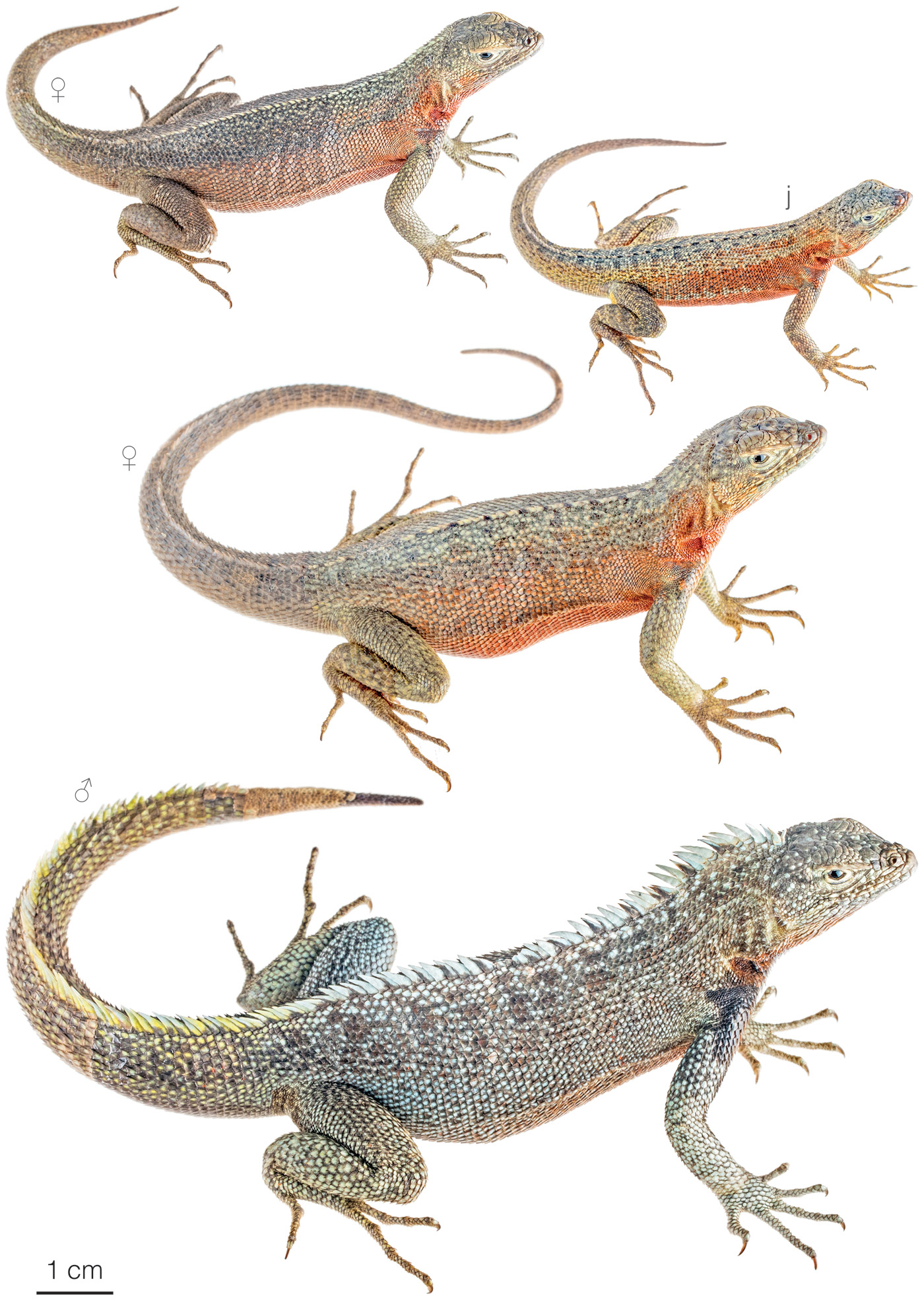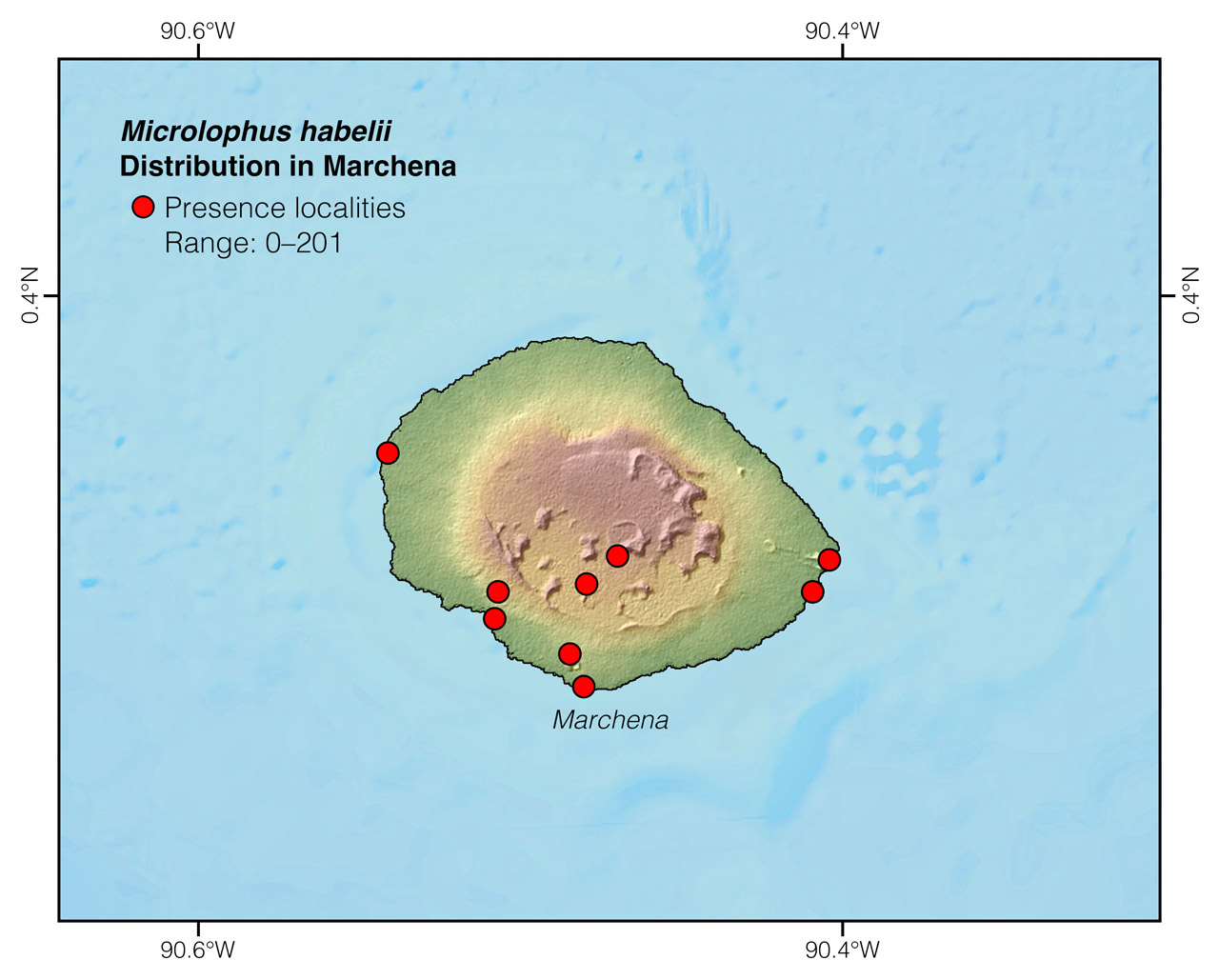Published October 10, 2019. Updated January 24, 2024. Open access. Peer-reviewed. | Purchase book ❯ |
Marchena Lava-Lizard (Microlophus habelii)
Reptiles of Ecuador | Sauria | Tropiduridae | Microlophus habelii
English common name: Marchena Lava-Lizard.
Spanish common name: Lagartija de lava de Marchena, lagartija de lava de Habel.
Recognition: ♂♂ 28.1 cmMaximum distance from the snout to the tip of the tail. Snout–vent length=10.3 cm. ♀♀ 22.6 cmMaximum distance from the snout to the tip of the tail. Snout–vent length=8.4 cm..1,2 Microlophus habelii is easily distinguishable from other native lizards occurring on Floreana Island (that is, iguanas and leaf-toed geckos) by having keeled scales on the tail, a skin fold above the shoulder, a raised mid-dorsal crest, and a conspicuously enlarged interparietal scale.1 Microlophus habelii is the only lava lizard occurring on Marchena Island. Adult males are larger than females and easily recognized by their spiked middorsal crest (Fig. 1). In contrast with most Microlophus species in Galápagos, females of the Marchena Lava-Lizard lack a red face coloration.1

Figure 1: Individuals of Microlophus habelii from Punta Mejía, Marchena Island, Galápagos, Ecuador. j=juvenile.
Natural history: Microlophus habelii is a diurnal lizard that inhabits volcanic rock areas and seasonally dry forests of Marchena Island.1 During the early morning and late afternoon, Marchena Lava-Lizards may be seen basking and foraging on soil, rocks, and trunks.1 To avoid the hot midday hours, they move into the shade, sitting on surfaces that have not been heated by the sun. At night, they hide among rocks, beneath soil, and in leaf-litter. Their diet is generalist, including insects, blossoms, seeds, and berries, but also members of their own species.3,4 Males perform pushup displays and fight with other males to defend territories.1 Females lay 2–3 eggs per clutch.4
Conservation: Least Concern Believed to be safe from extinction given current circumstances..5 Microlophus habelii is listed in this category because the species is not facing major immediate threats of extinction. Marchena Island is not populated by humans or by major introduced lizard predators and is protected within the Galápagos National Park.5 However, since M. habelii is restricted to a small island, it is prone to be affected by random unpredictable events (like droughts and introduced predators) within a short time period.1
Distribution: Microlophus habelii is endemic to Marchena, a 130 km2 island in Galápagos, Ecuador (Figs 2, 3).

Figure 2: Distribution of Microlophus habelii in Galápagos. See Appendix 1 for a complete list of the presence localities included in the map.

Figure 3: Distribution of Microlophus habelii in Marchena Island. See Appendix 1 for a complete list of the presence localities included in the map.
Etymology: The generic name Microlophus comes from the Greek words mikros (=small) and lophos (=crest).1 The specific epithet habelii honors Simeon Habel,6 a New York ornithologist who visited Galápagos in 1868–1869 and collected hundreds of animal and plant specimens.
See it in the wild: Marchena Island is inaccessible to tourism. Researchers and members of the Galápagos National Park may visit the habitat of Microlophus habelii, but only in the context of a scientific expedition or a conservation action.
Authors: Alejandro Arteaga,aAffiliation: Fundación Khamai, Reserva Arlequín, Ecoruta Paseo del Quinde km 56, Santa Rosa de Mindo, Pichincha 171202, Ecuador. Gabriela Aguiar,bIndependent researcher, Quito, Ecuador. and Juan M GuayasamincAffiliation: Universidad San Francisco de Quito, Quito, Ecuador.
Academic reviewers: Edgar Benavides,dAffiliation: Yale University, New Have, USA. John Rowe,eAffiliation: Alma College, Alma, USA. and Cruz MárquezfAffiliation: University of Rome Tor Vergata, Rome, Italy.
Photographer: Jose VieiragAffiliation: Tropical Herping (TH), Quito, Ecuador.,hAffiliation: ExSitu, Quito, Ecuador.
How to cite? Arteaga A, Aguiar G, Guayasamin JM (2024) Marchena Lava-Lizard (Microlophus habelii). In: Arteaga A, Bustamante L, Vieira J (Eds) Reptiles of Ecuador: Life in the middle of the world. Available from: www.reptilesofecuador.com. DOI: 10.47051/WJJW2059
Literature cited:
- Arteaga A, Bustamante L, Vieira J, Tapia W, Guayasamin JM (2019) Reptiles of the Galápagos: life on the Enchanted Islands. Tropical Herping, Quito, 208 pp. DOI: 10.47051/AQJU7348
- Bowman RI (1966) Proceedings of the Symposia of the Galápagos International Scientific Project. University of California Press, Berkeley, 336 pp.
- Van Denburgh J, Slevin JR (1913) Expedition of the California Academy of Sciences to the Galápagos Islands, 1905-1906. IX. The Galapagoan lizards of the genus Tropidurus with notes on iguanas of the genera Conolophus and Amblyrhynchus. Proceedings of the California Academy of Sciences 2: 132–202.
- Carpenter CC (1970) Miscellaneous notes on Galápagos lava lizards (Tropidurus: Iguanidae). Herpetologica 26: 377–386.
- Márquez C, Cisneros-Heredia DF (2016) Microlophus habelii. The IUCN Red List of threatened species. Available from: www.iucnredlist.org. DOI: 10.2305/IUCN.UK.2016-1.RLTS.T48444784A48444792.en
- Steindachner F (1876) Die Schlangen und Eidechsen der Galápagos-Inseln. Verhandlungen der Zoologisch-Botanischen Gesellschaft in Wien 1876: 303–329.
Appendix 1: Locality data used to create the distribution map of Microlophus habelii in Ecuador (Fig. 2). Go to the section on symbols and abbreviations for a list of acronyms used.
| Country | Province | Locality | Source |
| Ecuador | Galápagos | Crater in south of island | iNaturalist; photo examined |
| Ecuador | Galápagos | Lava river | iNaturalist; photo examined |
| Ecuador | Galápagos | Marchena, center of island | Benavides et al. 2009 |
| Ecuador | Galápagos | Marchena, SE corner | Arteaga et al. 2019 |
| Ecuador | Galápagos | Playa Negra, SE corner | Arteaga et al. 2019 |
| Ecuador | Galápagos | Playa Negra, W end | iNaturalist; photo examined |
| Ecuador | Galápagos | Punta Calle | Arteaga et al. 2019 |
| Ecuador | Galápagos | Punta Espejo | Arteaga et al. 2019 |
| Ecuador | Galápagos | Punta Mejía | Arteaga et al. 2019 |